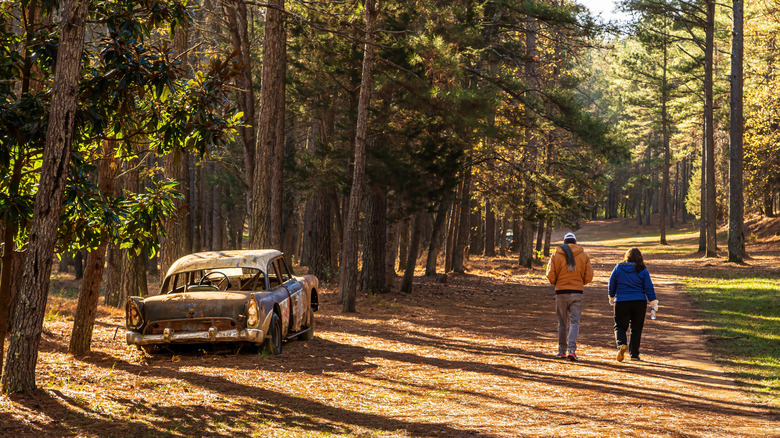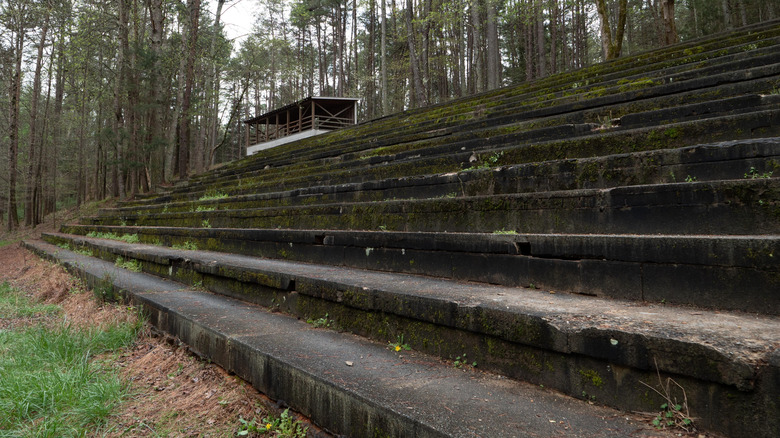North Carolina's Once-Abandoned Nascar Track Is Now A Thriving Walkable Green Space And Landmark
Strolling down the quiet paths in rural North Carolina, you may find it hard to imagine early stock cars roaring by at 80 miles per hour. As you pass the row of weathered concrete bleachers, you may wonder how as many as 20,000 spectators once filled this space, cheering for their favorite drivers. This was a place of noise and fumes, fast-food concessions, and scampering pit crews. Where trees and songbirds now reign, the most daring racers in the world once revved their engines, then careened around 200 laps on these very grounds. Back in the 1940s, the peaceful woodlands of Occoneechee Speedway became one of NASCAR's first major stomping grounds.
Today, the most visible signs of that heritage are the occasional rusted, gutted automobiles laid to rest along the margins of the hiking trails. These old vehicles are quiet now, but they recall a time, just after World War II, when NASCAR drivers competed in beefed-up street vehicles. You'll also see an old ticket booth, defunct telephone poles, and other artifacts from the speedway's heyday — each one a dream for antique car enthusiasts and artistically minded photographers.
Some visitors may find this area ghostly and surreal, while others will take comfort in nature's rebound. The trail is about as easy as it gets, with level ground and a total length of 1.3 miles; a casual walker should complete the there-and-back route in less than an hour. If you're already headed to Durham, a North Carolina college city that's a true cultural melting pot (and the line-dancing capital of America), Occoneechee makes for a unique historical side trip.
The unlikely origins of the Occoneechee Speedway
Named after an Indigenous nation that once lived in this region, Occoneechee Speedway began as farmland that included a race track for horses. According to local lore, one day in the 1940s, William "Bill" France Sr., the co-founder of NASCAR and a pilot, flew his plane over the Orange County countryside and spotted the track below. Inspired, France envisioned a speedway for auto racing right on that very spot. The speedway was constructed shortly thereafter, and the first race under the NASCAR Strictly Stock Series (which then became the Winston Cup) was held in 1949. The traditional oval track was composed of dirt, so cars often skidded around the curves, and there were substantial guardrails, giving Occoneechee a reputation for danger — especially in the 1960s when the cars reached greater speeds.
The speedway thrived for nearly three decades; the original concrete seating was designed for 5,000 spectators, but wooden bleachers were soon added to accommodate growing crowds. Races attracted some of the most famous drivers of the day; a standout was Louise Smith, one of the first women to compete in NASCAR and a celebrity in her time. Eventually, Occoneechee lost favor among fans and was closed in 1968; many of the structures were abandoned without fanfare. Today, nearby Charlotte is considered the capital of NASCAR, and nearly all dirt-oval tracks have been phased out of the national circuit.
For the next several decades, the 44-acre parcel lay neglected and nearly forgotten. Thanks to preservation efforts, Occoneechee was added to the National Registry of Historic Places in May 2002, and an official path was opened to the public. In 2025, the former speedway was absorbed into the larger Eno River State Park.
Visiting the park and where to stay
Occoneechee is free to visit, with a gravel parking lot and clear signage. The closest cities are Durham, about 15 minutes away by car, and Chapel Hill, about 20 minutes away; that proximity has made the trail a popular destination for both Duke and UNC students looking to commune with nature. Fittingly for a former NASCAR hub, the trailhead is difficult to reach without driving. The park is also right next to Hillsborough, an arty small town with award-winning dining. Hillsborough has a handful of accommodations; Durham has dozens more, with most rooms typically priced between $100 and $200 per night.
If you're drawn to the Occoneechee Raceway for its NASCAR heritage, consider timing your visit to coincide with Hillsborough's Hog Day BBQ Festival, a major community event held each September. You'll find food and live music, of course, but Hog Day also showcases classic cars in a downtown parking lot. And unlike the models that were left behind on the Occoneechee trail, these beauties still run.
Many visitors to North Carolina head straight to the Atlantic coast, which is understandable; it's hard not to hear the siren song of the Outer Banks, especially in summer. But the state's inland counties offer outdoor pleasures year-round. The region is webbed with hiking routes for all ages and levels of experience, and North Carolina's dazzling lake outside Durham is an outdoor paradise with a beach and scenic trails. You can race it from Occoneechee in about half an hour.


